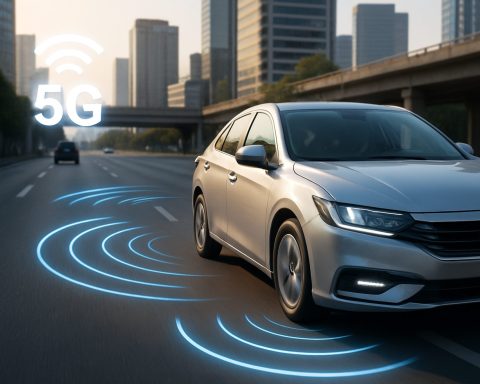- The electric vehicle (EV) market is rapidly transforming the automotive industry, driven by environmental concerns and regulatory pressures.
- EVs contribute to reducing carbon footprints, improving urban air quality, and decreasing oil dependency.
- Advancements in battery technology, including solid-state batteries, promise enhanced charging speeds and longer travel ranges.
- Expansion of charging infrastructure is alleviating range anxiety, essential for broader EV adoption.
- China leads globally in EV infrastructure, followed by Europe and North America with strong governmental support and industry investments.
- Challenges include high transition costs and ethical concerns over battery material sourcing.
- Despite hurdles, decreasing costs and technological integration offer opportunities for widespread EV adoption and innovation.
Streets humming with possibility, free from the growl of combustion engines, herald the future of transportation—an electric future growing steadily around the globe. The electric vehicle (EV) market is not just evolving; it’s electrifying the automotive industry with unprecedented momentum. As environmental urgency escalates and governments impose firmer regulations on emissions, the allure of EVs has surged, transcending novelty status to cement itself as a cornerstone of sustainable progress.
Imagine a world with reduced carbon footprints, where city air breathes lighter, and oil dependency becomes a relic of the past. The allure of this vision has unfurled an expansive tapestry of technological innovation and strategic initiatives, laying the groundwork for a transformative shift in transportation. As of 2023, electric vehicles already represent a dynamic segment that is poised to revolutionize the automotive landscape by 2030.
Beneath the Hood of Complexity
The landscape of EV technology reveals an intricate dance of advancements and ambitions. Key to their success is the evolution of battery technology, where breakthroughs in energy density, lifespan, and rapid charging lead a ceaseless charge. Lithium-ion batteries, once unrivaled, now face enticing competition from solid-state alternatives, offering promises of quicker charging times and amplified travel ranges.
Meanwhile, as charging infrastructure expands, urban landscapes are transforming. Charging stations sprout like urban oases, mitigating the specter of range anxiety that once haunted potential EV drivers. The global narrative of EV adoption is punctuated by the persistent hum of progress.
A Global Race
Globally, China dominates the leaderboard with an expansive network of charging facilities and robust governmental backing. Powers such as BYD and NIO cradle burgeoning ambitions, poised to shape the world’s future mobility. Meanwhile, Europe, with its climate goals as resolute as its architecture, speeds ahead, fueled by incentives and progressively stricter emission standards.
Across the Atlantic, North America’s embrace intensifies, bolstered by Tesla’s trailblazing presence and policy pushes from the Biden administration. Automakers, electrified by market trends, expedite their eco-conscious offerings, echoing the people’s choice for a cleaner tomorrow.
The Promise and the Pathway
While EVs swiftly glide toward ubiquity, challenges veer into view. The costs of switching from fossil to electron remain a hurdle, potentially stalling the broader accessibility of electric mobility. Furthermore, harvesting battery materials raises ethical and environmental queries that necessitate vigilant stewardship and sustainable practices.
Yet, amidst challenges, opportunities proliferate. As costs dwindle, ownership becomes less prohibitive—a harbinger of wider adoption. Meanwhile, the marriage of cutting-edge automotive technologies and EV frameworks spawns potential innovations—imagine autonomous electric fleets revolutionizing urban transit.
As the electric vehicle race charges into a momentous era, it embodies more than just a technological leap. It is a commitment to a world where sustainability leads and innovation transforms. The journey is ongoing, charged by our collective drive for a better, cleaner world. Where electrified roads meet eager adventurers keen to witness the dawn of an automotive renaissance.
Electric Vehicles: The Game Changer Transport Revolution Unfolded
Understanding the Electric Vehicle Revolution
The electric vehicle (EV) market is more than just a new twist in automotive technology; it is an epic transformation shaping the future of transportation worldwide. As 2023 unfolds, the industry stands at a pivotal juncture, with EVs projected to redefine the automotive landscape by 2030 because of innovation, environmental concerns, and robust policy support. Let’s delve deeper into the facets that were less explored in the initial source material.
The Quantum Leap in Battery Technology
Game-Changing Batteries
The cornerstone of EV success is undeniably battery technology. Recent advancements in solid-state batteries are revolutionizing the industry with promises of longer life cycles, faster charging times, and greater efficiency. Solid-state batteries, which replace the liquid or gel-form electrolyte with a solid electrolyte, allow for higher energy densities and are considered safer than their lithium-ion counterparts.
Market Movement
According to a report from Bloomberg New Energy Finance, the cost per kilowatt-hour (kWh) of EV batteries could fall below $100 by 2025, making EVs more affordable to the general public. This reduction in price is critical for achieving price parity with internal combustion engine vehicles.
Charging Infrastructure & Global Initiatives
Urban Transformation
The expansion of charging infrastructure is also pivotal. Major urban centers are burgeoning with charging stations, thanks to both private and governmental initiatives. Companies such as ChargePoint and Electrify America are rapidly expanding their networks across continents.
Global Leaders
– China: With over 800,000 public charging points, China leads the race backed by state support. Companies like BYD are integrating solar technology into charging stations, further promoting clean energy.
– Europe: Ambitious targets, such as the European Green Deal, push for over one million public charging stations by 2025. The EU’s intent to phase out internal combustion engines by 2035 underlines its commitment.
– North America: The Biden Administration’s infrastructure plan includes $7.5 billion to build a national network of 500,000 charging stations by 2030.
Adoption Challenges and Sustainable Practices
Overcoming Barriers
Despite the optimism, transitioning from fossil fuels presents challenges. The initial cost of EVs is still a barrier for mass adoption. Additionally, ethical concerns about the sourcing of lithium and cobalt for batteries necessitate responsible mining practices and recycling innovations.
Sustainability Initiatives
Environmental best practices are being integrated into the entire lifecycle of EVs. Companies are looking into second-life applications for EV batteries, transforming them into static energy storage solutions—aiding in grid stabilization and renewable integration.
Future Predictions & Innovations
Toward Autonomy
The synergy between EVs and autonomous driving technologies is expected to unlock new paradigms in urban transportation. Cities might see fleets of autonomous electric taxis reducing traffic congestion and improving urban air quality.
Market Forecasts
By 2030, analysts predict that over 50% of new car sales globally will be electric, driven by falling battery costs, favorable regulations, and increased consumer awareness of environmental issues.
Actionable Recommendations for Potential EV Owners
– Research Incentives: Explore government incentives such as tax credits and rebates which can reduce overall costs.
– Assess Energy Needs: Evaluate your typical driving range to choose an EV model with a suitable battery capacity.
– Installation Planning: Consider home charging station installation for added convenience and potential energy savings.
For further information and updates about the cutting-edge future of transportation, visit the websites of companies leading in this sector like Tesla, or check the latest industry reports on sites like Bloomberg and IHS Markit.
This complex yet thrilling journey toward an electrified future epitomizes more than a technological shift; it signifies a global commitment to sustainable innovation and a cleaner environment. Whether it’s exploring new battery technologies or the latest charging solutions, the horizon gleams with possibilities.












